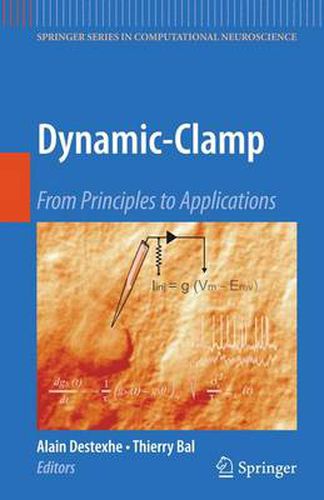Readings Newsletter
Become a Readings Member to make your shopping experience even easier.
Sign in or sign up for free!
You’re not far away from qualifying for FREE standard shipping within Australia
You’ve qualified for FREE standard shipping within Australia
The cart is loading…






This title is printed to order. This book may have been self-published. If so, we cannot guarantee the quality of the content. In the main most books will have gone through the editing process however some may not. We therefore suggest that you be aware of this before ordering this book. If in doubt check either the author or publisher’s details as we are unable to accept any returns unless they are faulty. Please contact us if you have any questions.
Dynamic-clamp is a fascinating electrophysiology technique that consists of merging living neurons with computational models. The dynamic-clamp (also called conductance injection ) allows experimentalists and theoreticians to challenge neurons (or any other type of cell) with complex conductance stimuli generated by a computer.
The technique can be implemented from neural simulation environments and a variety of custom-made or commercial systems. The real-time interaction between the computer and cell also enables the design of recording paradigms with unprecedented accuracy via a computational model of the electrode. Dynamic-Clamp: From Principles to Applications contains contributions from leading researchers in the field, who investigate these paradigms at the cellular or network level, in vivo and in vitro, and in different brain regions and cardiac cells. Topics discussed include the addition of artificially-generated synaptic activity to neurons; adding, amplifying or neutralizing voltage-dependent conductances; creating hybrid networks with real and artificial cells; attaching simulated dendritic tree structures to the living cell; and connecting different neurons.
This book will be of interest to experimental biophysicists, neurophysiologists, and cardiac physiologists, as well as theoreticians, engineers, and computational neuroscientists. Graduate and undergraduate students will also find up-to-date coverage of physiological problems and how they are investigated.
$9.00 standard shipping within Australia
FREE standard shipping within Australia for orders over $100.00
Express & International shipping calculated at checkout
This title is printed to order. This book may have been self-published. If so, we cannot guarantee the quality of the content. In the main most books will have gone through the editing process however some may not. We therefore suggest that you be aware of this before ordering this book. If in doubt check either the author or publisher’s details as we are unable to accept any returns unless they are faulty. Please contact us if you have any questions.
Dynamic-clamp is a fascinating electrophysiology technique that consists of merging living neurons with computational models. The dynamic-clamp (also called conductance injection ) allows experimentalists and theoreticians to challenge neurons (or any other type of cell) with complex conductance stimuli generated by a computer.
The technique can be implemented from neural simulation environments and a variety of custom-made or commercial systems. The real-time interaction between the computer and cell also enables the design of recording paradigms with unprecedented accuracy via a computational model of the electrode. Dynamic-Clamp: From Principles to Applications contains contributions from leading researchers in the field, who investigate these paradigms at the cellular or network level, in vivo and in vitro, and in different brain regions and cardiac cells. Topics discussed include the addition of artificially-generated synaptic activity to neurons; adding, amplifying or neutralizing voltage-dependent conductances; creating hybrid networks with real and artificial cells; attaching simulated dendritic tree structures to the living cell; and connecting different neurons.
This book will be of interest to experimental biophysicists, neurophysiologists, and cardiac physiologists, as well as theoreticians, engineers, and computational neuroscientists. Graduate and undergraduate students will also find up-to-date coverage of physiological problems and how they are investigated.